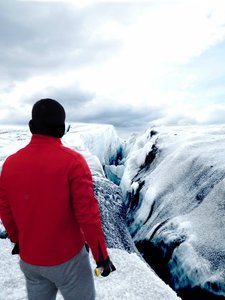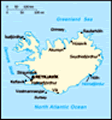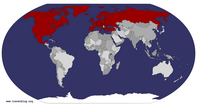Advertisement

 Skaftafell National Park
Skaftafell National Park
A crevasse in Vatnajokull, Europe's largest glacier and the site of many Hollywood films: "Batman Begins", "Interstellar", "James Bond", and "Game of Thrones".Iceland is a country of dichotomy. Ingolfr Arnarson, the island's first permanent settler in the 9th century, probably had a hard time naming this place because it was so bipolar; between the glaciers, volcanoes, grasslands, mountains, beaches, and yes, even ice, you'll encounter almost any conceivable biome here, so it really should have been called "Everythingland." While the geography may be unforgiving, one cannot deny the natural beauty of this rugged terrain, which is both a blessing and a curse. The arid landscape in the center of the island--dubbed the "Highlands"--is predominantly uninhabitable, forcing residents to take refuge along the coast. Despite the harsh conditions, these natural resources are also this nation's lifeline. The abundant geothermal and hydropower energy made this the largest electricity producer per capita in the world. The vast water supply is also considered the purest on the planet, helping make Iceland the cleanest country on Earth. And since water is their livelihood, every town has a swimming pool and Icelanders love their sushi, so much so that wars have been waged over fishing rights. Their fish-based diet has also boosted Icelanders' life expectancy to 82 years, fourth highest in the world. It doesn't hurt either, that they

 Skogafoss
Skogafoss
Hiking on the blocked-off gravel paths that veer off the stairs leads you to this breathtaking vista overlooking the waterfall. popularized universal healthcare before Obama made it cool, as well as offered a free college education to everyone, turning these people into one of the globe's healthiest and most literate, not to mention the strongest, as evidenced by their eight "World's Strongest Man" titles.
And maybe it's these strong men that have deterred foreign invaders, for Iceland has no standing army and is fervent about their neutrality, even through two World Wars when it seemed like the Nazis occupied every nation except the Cherokee. Couple that with socio-political stability and a low crime rate, and you've got the most peaceful country on Earth, according to the Global Peace Index. Icelanders take pride in this fact by leaving strollers with babies on the streets unattended while eating or shopping, whereas those who do this in the States would be ostracized on the local evening news. Speaking of the States, it was America that turned Iceland into one of the most developed countries globally before the financial crisis of 2008, thanks to technological advances in agriculture and fishing introduced by "those damn Yankees."
But when the national banks collapsed during the '08 recession, Iceland once again relied on its most

 Blue Lagoon
Blue Lagoon
Iceland's most popular attraction is a geothermal pool heated by nearby lava flow and is considered one of the World's 25 Wonders. dependable resource, nature, to lift its flailing economy via tourism. The recent advent of WOW Air, a low-cost carrier flying between the U.S. (Boston/Washington D.C.), Iceland (Reykjavik), and mainland Europe, aided this cause greatly. In fact, Kristina and I bought tickets for the inaugural flight from BWI to Reykjavik for a measly $410, and another ticket from Reykjavik to Copenhagen for $170 (includes luggage), attesting to the unbelievable value of this airline. But before you pack your bags and head off to the "Land of Fire and Ice," heed our advice and things to avoid as you plan your trip.
First, you must rent a car. There's no way around it. Reykjavik, the capital, will only occupy a day or two, so to truly experience this country, you have to drive around the Ring Road (Route 1) that encircles the island. The most popular itinerary--which we attempted our first day in Iceland--is going east from downtown along the southern coast where you will visit Selfoss (small town with nothing to see), Seljalandsfoss (famous waterfall where you can walk behind the water), Gljufrafoss (hidden waterfall within the rocks only one minute from Seljalandsfoss,), Skogafoss (one of Iceland's biggest waterfalls where

 Seljalandsfoss
Seljalandsfoss
Along the southern coast on Route 1, this is one of the few waterfalls you can walk behind.a short hike up the stairs provides great views of the rushing water below), Dyrholaey (seaside cliffs with gateway arches), Vik (quaint town with black sand beaches and rock formations in the sea), Skaftafell National Park (includes Svartifoss waterfall and Vatnajokull, Europe's largest glacier), and Jokulsarlon (amazingly blue glacial lagoon). The total one-way drive-time is 4.5 hours without stops, so plan accordingly.
Another popular itinerary is the "Golden Circle", a much shorter drive we accomplished our second day in Iceland, leading you northeast from Reykjavik on Route 1 and passing through Thingvellir National Park (site of the world's first Parliament), Silfra (inside Thingvellir, a scuba diving mecca where the North American and European tectonic plates meet), Geysir (namesake and home of the original "geyser", as well as the active Strokkur geyser that erupts every 10 minutes), and Gullfoss (Iceland's largest and most popular waterfall). The total one-way drive-time is 2 hours, a manageable day-trip from Reykjavik.
If you're feeling adventurous or have more time, plan 5 to 7 days for driving around the entire island. Go whale watching, photograph some puffins, pet an Icelandic horse, visit a Viking town, or swim in a geothermal bath. Whatever your heart

 Gullfoss
Gullfoss
Iceland's largest and most popular waterfall feels like a crack in the Earth with gushing water. desires, have at it, but make sure you have the means, which brings us to our second advice: if you're bringing a credit card, make sure it has a PIN.
While PINs are only required in America for DEBIT cards, things work differently across the pond, which can be very inconvenient if you're not prepared. Automated gas pumps only accept credit cards with a PIN, and since many towns are miles apart, you're SOL if you're caught on an empty tank with no cash or credit. Believe us, you don't want to be stuck in a desolate town at night hitching a ride to the nearest gas station the next mountain range over, even if the Northern Lights are out for you to enjoy during your trek (only during the winter though). Despite hitchhiking being fairly common on the highways of Iceland, a non-functioning car in an unpopulated area is one of the worst mishaps possible in a country where AAA can't do s*** for you. With that said, our third tip is to make sure you have a reliable car.
Almost all cars in Iceland are manual, so unless you're familiar with handling a stick, double check

 Svinafellsjokull
Svinafellsjokull
Hiking on a glacier tongue of Vatnajokull, Europe's largest glacier.to ascertain yours is an automatic, even if it means paying extra. We opted for the manual in hopes of shaving a few bucks, but it caused headaches the first day as I was getting acclimated, like stalling on a hill and rolling backwards down a (thankfully) empty road. Also check that your rental has both front and back license plates, lights that are operational, tires that are in good condition, etc. Be aware that lights are required to be turned on at all times, right turns on red are prohibited, "F-roads" are forbidden for non-4x4 cars, and cameras within city limits monitor and ticket for speeding, so don't rush to the Blue Lagoon before it closes at 8 p.m.
With regards to the Blue Lagoon, our fourth tip is to visit this straight from or to the airport. Many don't realize the Blue Lagoon--Iceland's most popular attraction--is only 20 minutes from Keflavik International, but 40 minutes from Reykjavik. If you bring your own towel and flip-flops, this spa will provide everything else for 35 euros, the cheapest package they offer. This geothermal bath is one of
National Geographic's 25 Wonders of the World, among the likes of the

 Silfra
Silfra
Located in Thingvellir National Park--the site of the world's first Parliament--Silfra is a scuba diver's mecca where the N. American and European tectonic plates meet. Great Barrier Reef and Mount Everest. The nearby lava flow heats the creamy blue water, which circulates into the lagoon and renews itself every 2 days. People claim the silica mud is good for your skin so you'll have to come and experience it for yourself, but be warned, the spa requires you to shower naked before entering. With beer bellies and thunder thighs galore, this is quite a sight to behold in and of itself; and people said Europeans were fit...
Our last tip involves food. Icelandic cuisine is unremarkable except for a couple of dishes, so after you've sampled these select few at restaurants (no need to tip), use the grocery stores to stock up on snacks for your long drives, because the only thing more expensive than dining out in Iceland is Oprah's penthouse. However, places worth trying are Saegreifinn (Geirsgata 8) and Baejarins Beztu Pylsur (Tryggvagotu 1). The former is an authentic, hole-in-the-wall seaside restaurant offering only fresh-caught fare, and the latter is rated the #1 hotdog stand in the world. Saegreifinn is famous for their creamy lobster soup with endless bread, kebabs that they grill to order, and whale samples that look like steak

 Blue Ice Experience
Blue Ice Experience
A tour we booked with Icelandic Mountain Guides lasting 2-3 hoursbut taste like fish. A meal here costs about $10, a bargain in this expensive country. As for Baejarins Beztu Pylsur, their lamb hotdogs with diced onions, fried onions, ketchup, and sweet remoulade sauce are to die for. Whether they deserve their "World's #1" Title is up for debate, but it doesn't discount their deliciousness and great value, especially when Bill Clinton agrees.
Once you've tried these staples, go to groceries stores like Bonus, Kronan, or Netto to load up on snacks, such as the famous Icelandic "yogurt" Skyr, which is actually a sour cheese. Also get the infamous hakarl (fermented shark) from vendors around town, like those at the Kolaportid weekend market (Tryggvagata 19). This flea market is also a great place for buying Iceland's trademark wool sweaters called "lopapeysa" for approximately $60, which normally retails for over $100 at other stores.
After you're stuffed, make sure to explore Reykjavik's quaint city center. The main street running through the heart of downtown is Laugavegur, which turns into Bankastraeti and Austurstraeti, all good places for shopping, eating, drinking, or simply strolling. The iconic Hallgrimskirka Church is located diagonally off of Laugavegur on a street called Skolavordustigur, so make

 Hallgrimskirka Church
Hallgrimskirka Church
Reykjavik's most famous landmark with the island's first permanent settler, Ingolfr Arnarson.sure to veer off to visit this landmark. Along the way is a cute ice cream parlor called Eldur Og On that's worth a quick visit. If you want to join a guided tour group, there's a free tour everyday from May to mid-September at noon and 2 p.m., rain or shine. They meet at Laekjartorg Square under the little clock tower, the tours lasts 80 minutes, and as always, tips are welcomed. While we failed to take advantage of this, Kristina and I spent a large portion of our last day in Iceland just leisurely wandering the streets of Reykjavik, which surprisingly, has become one of our favorite downtown areas in the world. The only thing we would have changed was the clothes we packed; locals argue the climate here is temperate due to the Gulf Stream, inferring that Iceland has mild winters and cool summers, but we beg to differ and strongly suggest you bring plenty of layers. You'll encounter rain, snow, sleet, hail, wind, and sunshine within a 15-minute span, but that shouldn't be discouraging because surprises are all part of Iceland's charm.
While folklore claims the Vikings only named the island, "Iceland," to dissuade others

 Old Harbor
Old Harbor
View of Reykjavik's pristine harbor, surrounded by majestic mountains and crisp waters.from settling in their newly discovered paradise, take this tale with a grain of salt because the country definitely lives up to its name. Come with a plan and be prepared, but don't have expectations or be stringent with your itinerary, for you'll likely go off the map, off schedule, and off-road. Iceland is a land of extremes, so be mindful of your environment while enjoying your surroundings, because this trip will be unlike any you've ever taken.
Advertisement
Tot: 0.049s; Tpl: 0.012s; cc: 9; qc: 23; dbt: 0.0191s; 1; m:domysql w:travelblog (10.17.0.13); sld: 1;
; mem: 1.1mb














